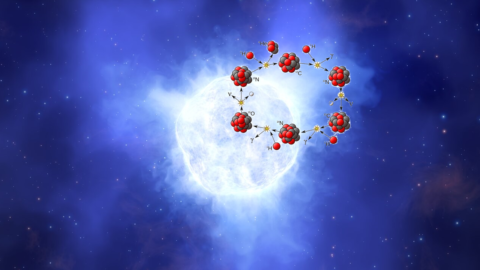When a star bares all

FAU researchers investigate a former binary star that has lost its surrounding envelope.
A star in the Columba constellation, approximately 900 light years away, has been hiding a dark past, as has now been revealed by an international team of researchers led by FAU. Astronomer Dr. Andreas Irrgang from the Astronomical Institute at FAU’s Dr. Karl Remeis Observatory in Bamberg belongs to an international team of researchers who have now discovered that the star was once the heart of a binary star system that lost its envelope when it engulfed its companion.
The researchers have just published their results in the journal Nature Astronomy.
Energy from nuclear fusion
It has been known since the late 1930’s that stars generate their enormous radiation energy when hydrogen is fused to helium in reactions at temperatures reaching many millions of degree Celsius deep within the star’s core. This fusion results from reaction cycles involving carbon, nitrogen and oxygen as catalysts. This leads to the typical high concentration of nitrogen in the core of the star.
As stars tend to squander their nuclear energy reserves, they only exist for a few million years before disappearing in a gigantic explosion known as a supernova. This nuclear reaction is not normally visible, as the hot central reaction center is usually hidden beneath the very dense surface layers enveloping the star. Predictions of how stars develop can therefore only be tested by observing a great many stellar surfaces.
Exposed heart
FAU astronomer Dr. Andreas Irrgang and a colleague from the University of Innsbruck have been observing massive stars by using complex models to analyze spectroscopic images of numerous stars. They have now made a unique discovery: The chemical composition of the surface of the massive star Gamma Columbae in the southern Columba constellation is very different from what you would expect in a star with a comparable mass.
Together with a leading specialist in stellar development theory at the University of Geneva, the scientists led by Irrgang have found an explanation.
They have come to the conclusion that Gamma Columbae once belonged to a binary star system orbiting around a joint gravitational point with another star, and lost its envelope when it engulfed its counterpart.
It is perfectly normal for binary stars to move closer to each other and lose energy as a result. If both stars are in close proximity, the gravitational waves that cause the loss of energy are strong and have a major influence, as must have been the case in this instance. In the case of Gamma Columbae, the stellar core, or heart of the star, was revealed as a result of this process. This suggests that Gamma Columbae could in fact be the exposed core of an originally much larger star in a former binary star system.
Explosion predicted in one to two million years
Based on its current composition, Gamma Columbae is thought to have reached approximately 90 percent of its predicted 10 million year lifespan. Accordingly, it is expected to have less than two million years left before it explodes. Until then, Gamma Columbae is a valuable study object which researchers can use to conduct detailed investigations into the past and future of binary stars.
The press releases about the paper from the University of Geneva and the Swiss National Science Foundation are available online.
Original publication: doi.org/10.1038/s41550-022-01809-6
Further information
Prof. Dr. Ulrich Heber
Phone: +49 9131 5222 14
ulrich.heber@sternwarte.uni-erlangen.de
Dr. Andreas Irrgang
andreas.irrgang@sternwarte.uni-erlangen.de